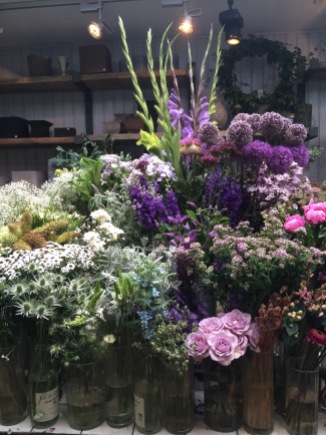Interview by Eric Hsu
Photography by Aviva Rowley (except credited otherwise)

A born and bred-Brooklynite, Aviva Rowley studied fine arts in Cooper Union during which she worked as a florist and continued to do so after graduation. Desiring something less temporal, Rowley turned to ceramics as a medium for holding flowers. She builds her vessels backwards, using her floristry background as an inspiration, and because her work is handmade, no piece is uniform and one of a kind. Texture and shape dictate her style while the matte black glaze unifies it. Please visit her site (www.avivarowley.com) or IG: @avivarowley.
For someone whose taste tends towards macabre, your ease and preference with clay as an artistic medium seem worlds away because clay, once fired, does not project rigor mortis. Clay feels alive and vital within one’s hands, hence why did you elect to work with it?
I never really thought of myself as macabre necessarily. It’s funny because clay, while it is alive and vital in one’s hands while wet, once you fire it, it definitely does project rigor mortis. Frozen in time. A huge part of why I started to make ceramics was the experience of building these huge events as a florist, just to watch everything die within a day or two. I wanted to create something more permanent and unchanging as a vessel for things to grow, fade, eventually die…

My parents have been a huge inspiration to me throughout my life. My mom is a psychologist and self-taught ceramist as well. I grew up playing with clay, and water and plants and weeds and dirt, with the backdrop of the wild city skyline. My father is a brilliant painter and scholar, who definitely leans towards the darkness. They both have been an incredible influence in my life as a creator. I grew up in Brooklyn and my kiln is still at my parents’ house, in the house I grew up in, next to my mother’s wild overgrown flower garden.
Constance Spry, perhaps the fore runner of the wild untamed floral style popular now, worked closely with Fulham Pottery in London to design and develop a series of ceramics for floral work. How did your florist training shape your perception towards ceramics, and has it influenced the form you prefer to work with?
It has completely changed how I think of the “vessel,” I consider what goes in my vessels while I am building them. I like to create lips and shapes that will speak to flowers. Some of my favorite forms I’ve built dictate the way the flowers fall – the slit vase, for example, lets flowers fall in a really elegant mohawk.

There needs to be a conversation between the vessel and what you put in it. Our mutual friend Phil has been one of my biggest inspirations. He would hate that I’m saying this, but he’s really been my muse for the past few years. I make vessels thinking about how he would use them, I add snakes and handles and knobs and gaps for him to twist around. While my own floral work is very simple, when I build a vessel I imagine so many possibilities – yet I’m always surprised how different florists use them.

Many of my dearest friends are still florists, which is a fascinating resource. I am working on a collaboration with another of my floral friend Sophia Moreno-Bunge. She lives in California so we have been doing a snail mail back and forth. Making vessels with her in mind has been such a fun experiment, and I’m creating forms that I never would have imagined otherwise.
In addition, you have started a Keiki-Club “to create an open social community for friends and flora fanatics to come together and grow plants, share knowledge, and trade collections”. Does this exposure to different plants and individuals besotted with them inspire your work in interesting directions?
One of the first ceramic pieces I built was a hanging saucer because it was an answer to a plant problem that had not been answered before. Being a part of such a positive community, where people can get together and tell stories, and introduce one another to new things… I never thought of it as an inspiration to my pottery, but now that I think of it, it is. I tend to like older plants, ones that have a past, and have been growing and adapting to their environments. I like to imagine my vessels as homes.

Some ceramicists experiment regularly with glazes because they feel that the functionality, which underwrites the vessel form, is an artistic limitation. You have deliberately kept your glazes to a matte black or a weathered beige despite how varied you have manipulated the forms.
I’ve always created intentional limitations in my art. I chose the gun metal / matte black glaze because it really speaks to flowers, and definitely lets me experiment more wildly with my shapes. When you see my vessels in person, there are a lot of slight imperfections in glazes; I’ve actually been experimenting a lot with different textures while keeping the black as a basic language.

I like how they appear as silhouettes, and work well on their own… when you add plants or flowers it adds a whole other dimension which is generally out of my control.
If an Aviva Rowley ceramic was a plant or garden, what would it be?
I would be an undiscovered underwater ruin, left alone for so many years and enveloped in overgrowth. My partner said I’d be Psychotria elata… look it up!
Thank you for the interview Aviva!
































You must be logged in to post a comment.